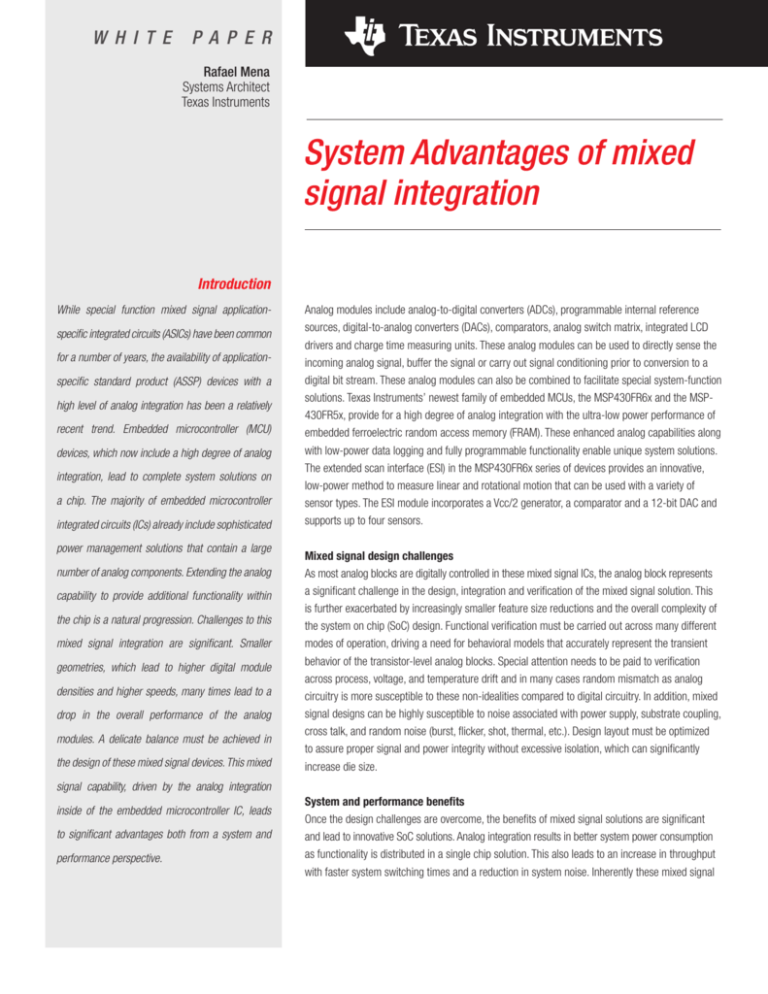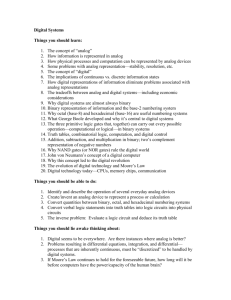System advantages of mixed signal integration
advertisement

W H I T E PA P E R Rafael Mena Systems Architect Texas Instruments System Advantages of mixed signal integration Introduction While special function mixed signal applicationspecific integrated circuits (ASICs) have been common for a number of years, the availability of applicationspecific standard product (ASSP) devices with a high level of analog integration has been a relatively recent trend. Embedded microcontroller (MCU) devices, which now include a high degree of analog integration, lead to complete system solutions on a chip. The majority of embedded microcontroller integrated circuits (ICs) already include sophisticated power management solutions that contain a large number of analog components. Extending the analog capability to provide additional functionality within the chip is a natural progression. Challenges to this mixed signal integration are significant. Smaller geometries, which lead to higher digital module densities and higher speeds, many times lead to a drop in the overall performance of the analog modules. A delicate balance must be achieved in the design of these mixed signal devices. This mixed Analog modules include analog-to-digital converters (ADCs), programmable internal reference sources, digital-to-analog converters (DACs), comparators, analog switch matrix, integrated LCD drivers and charge time measuring units. These analog modules can be used to directly sense the incoming analog signal, buffer the signal or carry out signal conditioning prior to conversion to a digital bit stream. These analog modules can also be combined to facilitate special system-function solutions. Texas Instruments’ newest family of embedded MCUs, the MSP430FR6x and the MSP430FR5x, provide for a high degree of analog integration with the ultra-low power performance of embedded ferroelectric random access memory (FRAM). These enhanced analog capabilities along with low-power data logging and fully programmable functionality enable unique system solutions. The extended scan interface (ESI) in the MSP430FR6x series of devices provides an innovative, low-power method to measure linear and rotational motion that can be used with a variety of sensor types. The ESI module incorporates a Vcc/2 generator, a comparator and a 12-bit DAC and supports up to four sensors. Mixed signal design challenges As most analog blocks are digitally controlled in these mixed signal ICs, the analog block represents a significant challenge in the design, integration and verification of the mixed signal solution. This is further exacerbated by increasingly smaller feature size reductions and the overall complexity of the system on chip (SoC) design. Functional verification must be carried out across many different modes of operation, driving a need for behavioral models that accurately represent the transient behavior of the transistor-level analog blocks. Special attention needs to be paid to verification across process, voltage, and temperature drift and in many cases random mismatch as analog circuitry is more susceptible to these non-idealities compared to digital circuitry. In addition, mixed signal designs can be highly susceptible to noise associated with power supply, substrate coupling, cross talk, and random noise (burst, flicker, shot, thermal, etc.). Design layout must be optimized to assure proper signal and power integrity without excessive isolation, which can significantly increase die size. signal capability, driven by the analog integration inside of the embedded microcontroller IC, leads to significant advantages both from a system and performance perspective. System and performance benefits Once the design challenges are overcome, the benefits of mixed signal solutions are significant and lead to innovative SoC solutions. Analog integration results in better system power consumption as functionality is distributed in a single chip solution. This also leads to an increase in throughput with faster system switching times and a reduction in system noise. Inherently these mixed signal 2 Texas Instruments designs also lead to simplified system designs with pre-verified aspects of the component integration. Signal and power integrity conformance to device specifications is verified through specification-based functional validation. In addition, mixed signal solutions incorporate analog components that can be fully controlled by software through intelligent connections enabled internally by the IC. This functionality also provides for a programmable internal reference source for the analog modules. Overall, the single-chip solution results in a reduction of the bill of materials (BOM) and PCB board size which translates to a significant potential system cost savings. Special system functions/Extended scan interfaceDAC output The analog front end provides a bridge between the real-world signal and the embedded microcontroller in the mixed signal solution. The integrated analog converts the continuous time domain signal into a digital bit stream that can be processed by the embedded microcontroller. This conversion occurs through simple comparators or more complex ADCs. Likewise, the analog component of the mixed signal device enables it to act on the world around it in the form of DACs. The digitally controlled analog modules perform a critical signal transformation to ensure signal compatibility within the system. In addition to this bridging functionality, the analog modules can be combined to create special-function solutions. These special-function solutions go beyond signal transformation and enable an interpretation of the data without MCU interaction. Typical examples of special-function analog solutions include charge time measuring units, various motor control solutions, RF conversion and special function solutions to measure position. The ESI module on MSP430FR6x MCUs provides an integrated analog module to measure linear and rotational motion with the lowest possible power consumption. The motion or rotational measurement is carried out by sensing the position of a wheel via inductance-type measurements. Rotation and direction detection using two inductive-capacitive (LC) sensors is shown in Figure 1. A single LC sensor allows only for rotation detection. This configuration is used to measure fluid flow by transforming the flow into rotation. The mechanical construction in the form of a screw wheel or worm wheel transforms the flow into a corresponding rotation. The plate sitting underneath the two LC sensors has a metal surface on half of the plate while the sensors themselves sit 90 degrees from each other. The metal surface acts as a damping factor during half the period of the rotational sequence; the rotation measurement is carried out by detecting the different damping factors. The ESI module on MSP430FR6x MCUs detects the amplitude of the sensor input signal and defines the relative position of the wheel. Speed is obtained by a continuous sampling of the LC sensors and correlates to fluid flow. Figure 1. Rotation detection using two LC sensors System Advantages of mixed signal integration June 2014 Texas Instruments 3 The integrated analog block module of the ESI unit consists of a comparator, a 12-bit DAC and a Vcc/2 generator along with digital circuitry to process the digital representations of the measurement sequence without the need of the host controller. In the case of LC sensor-based motion and rotational measurements, the analog block biases the sensors, and in a timed sequence defined by the user, senses the corresponding signal levels and transforms it to a digital bit stream. The ESI unit is measuring the effects of eddy currents generated on the conductive object near the resonant circuit and transforming it to position. Eddy currents are formed when a field comes in proximity to a conducting object. The integrated special-function solution of the LC scan interface drives very-low power needs given the hardware implementation of the sequence. As opposed to a software implementation, the host controller remains in a shutdown mode during the LC scan sequence which leads to the lowest overall power implementation of this type of position or rotational measurement technique. In addition, as discussed earlier, the fully integrated single-chip solution leads to many other system and power performance advantages. This LC resonant circuit implementation can also be used in contactless door switches where the damping factor or change in the LC tank’s oscillation amplitude provides position information. By properly tuning the LC circuit, this method can also be used as a proximity sensor in industrial applications. It can be used in place of mechanical buttons where a metal plate can be placed on the button and the distance to the LC circuit is detected via the ESI module. It can also be applied as a method for detecting different types of metals in a factory setting or in the consumer space such as in coin counters or portable metal detectors. In general, this technique can be used in any solution that measures a damping factor to determine a physical parameter. The ESI module provides for the lowest power implementation. Other sensor configurations can be enabled with the deactivation of the excitation mode while sensing either an analog or digital input sensor signal. This facilitates the ESI unit to be interfaced with other electromechanical, optoelectronic and magnetic sensors also used to measure linear position or angular motion. The output of the incremental encoders or angle transducers provides information on the motion of the rotating element which can then be converted to speed, distance and position. These motion or rotary encoders are used in system solutions that require exact and unconstrained shaft rotation. Inside of industrial sensor solutions, typical examples include robotics, industrial controls and process controls. In consumer electronics this technique can be used in wheel-based game consoles, special purpose photographic lenses and manual volume or tuning controls to name a few. In all these applications, the encoders come in the form of optical, mechanical, Hall Effect or capacitive types. Encoding of motion or rotation occurs by either physically, magnetically, through capacitive measurements or via optical detection of the element in motion. Conclusion While the challenges of mixed signal integration can be quite daunting, the benefits can be potentially very significant both from a systems and an overall performance perspective. Leveraging the integrated analog to create special-function solutions embedded in the MCU result in innovative system on chip solutions that push performance on many different levels. This is especially true for low-power applications. Further combining FRAM memory technology from TI’s newest family of MSP430FR5xxx and MSP430FR6xxx MCUs enable ultra-low power data-logging atop of the enhanced mixed signal performance provided by the analog integration. Important Notice: The products and services of Texas Instruments Incorporated and its subsidiaries described herein are sold subject to TI’s standard terms and conditions of sale. Customers are advised to obtain the most current and complete information about TI products and services before placing orders. TI assumes no liability for applications assistance, customer’s applications or product designs, software performance, or infringement of patents. The publication of information regarding any other company’s products or services does not constitute TI’s approval, warranty or endorsement thereof. The platform bar and MSP430 are trademarks of Texas Instruments. All other trademarks are the property of their respective owners. E010208 © 2014 Texas Instruments Incorporated SLAY031 IMPORTANT NOTICE Texas Instruments Incorporated and its subsidiaries (TI) reserve the right to make corrections, enhancements, improvements and other changes to its semiconductor products and services per JESD46, latest issue, and to discontinue any product or service per JESD48, latest issue. Buyers should obtain the latest relevant information before placing orders and should verify that such information is current and complete. All semiconductor products (also referred to herein as “components”) are sold subject to TI’s terms and conditions of sale supplied at the time of order acknowledgment. TI warrants performance of its components to the specifications applicable at the time of sale, in accordance with the warranty in TI’s terms and conditions of sale of semiconductor products. Testing and other quality control techniques are used to the extent TI deems necessary to support this warranty. Except where mandated by applicable law, testing of all parameters of each component is not necessarily performed. TI assumes no liability for applications assistance or the design of Buyers’ products. Buyers are responsible for their products and applications using TI components. To minimize the risks associated with Buyers’ products and applications, Buyers should provide adequate design and operating safeguards. TI does not warrant or represent that any license, either express or implied, is granted under any patent right, copyright, mask work right, or other intellectual property right relating to any combination, machine, or process in which TI components or services are used. Information published by TI regarding third-party products or services does not constitute a license to use such products or services or a warranty or endorsement thereof. Use of such information may require a license from a third party under the patents or other intellectual property of the third party, or a license from TI under the patents or other intellectual property of TI. Reproduction of significant portions of TI information in TI data books or data sheets is permissible only if reproduction is without alteration and is accompanied by all associated warranties, conditions, limitations, and notices. TI is not responsible or liable for such altered documentation. Information of third parties may be subject to additional restrictions. Resale of TI components or services with statements different from or beyond the parameters stated by TI for that component or service voids all express and any implied warranties for the associated TI component or service and is an unfair and deceptive business practice. TI is not responsible or liable for any such statements. Buyer acknowledges and agrees that it is solely responsible for compliance with all legal, regulatory and safety-related requirements concerning its products, and any use of TI components in its applications, notwithstanding any applications-related information or support that may be provided by TI. Buyer represents and agrees that it has all the necessary expertise to create and implement safeguards which anticipate dangerous consequences of failures, monitor failures and their consequences, lessen the likelihood of failures that might cause harm and take appropriate remedial actions. Buyer will fully indemnify TI and its representatives against any damages arising out of the use of any TI components in safety-critical applications. In some cases, TI components may be promoted specifically to facilitate safety-related applications. With such components, TI’s goal is to help enable customers to design and create their own end-product solutions that meet applicable functional safety standards and requirements. Nonetheless, such components are subject to these terms. No TI components are authorized for use in FDA Class III (or similar life-critical medical equipment) unless authorized officers of the parties have executed a special agreement specifically governing such use. Only those TI components which TI has specifically designated as military grade or “enhanced plastic” are designed and intended for use in military/aerospace applications or environments. Buyer acknowledges and agrees that any military or aerospace use of TI components which have not been so designated is solely at the Buyer's risk, and that Buyer is solely responsible for compliance with all legal and regulatory requirements in connection with such use. TI has specifically designated certain components as meeting ISO/TS16949 requirements, mainly for automotive use. In any case of use of non-designated products, TI will not be responsible for any failure to meet ISO/TS16949. Products Applications Audio www.ti.com/audio Automotive and Transportation www.ti.com/automotive Amplifiers amplifier.ti.com Communications and Telecom www.ti.com/communications Data Converters dataconverter.ti.com Computers and Peripherals www.ti.com/computers DLP® Products www.dlp.com Consumer Electronics www.ti.com/consumer-apps DSP dsp.ti.com Energy and Lighting www.ti.com/energy Clocks and Timers www.ti.com/clocks Industrial www.ti.com/industrial Interface interface.ti.com Medical www.ti.com/medical Logic logic.ti.com Security www.ti.com/security Power Mgmt power.ti.com Space, Avionics and Defense www.ti.com/space-avionics-defense Microcontrollers microcontroller.ti.com Video and Imaging www.ti.com/video RFID www.ti-rfid.com OMAP Applications Processors www.ti.com/omap TI E2E Community e2e.ti.com Wireless Connectivity www.ti.com/wirelessconnectivity Mailing Address: Texas Instruments, Post Office Box 655303, Dallas, Texas 75265 Copyright © 2014, Texas Instruments Incorporated






